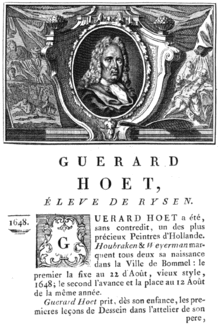Gerard Hoet
Gerard Hoet | |
|---|---|
 Gerard Hoet, in artist biographies by Jean-Baptiste Descamps | |
| Born | 22 August 1648 |
| Died | 2 December 1733 (aged 85) |
| Nationality | Dutch |
| Known for | Painting and engraving |
| Movement | Dutch Golden Age painting |
Gerard Hoet (Dutch:
Biography
Gerard Hoet trained with his father and brother who were glass painters, and Warnard van Rijsen, who lived in Zaltbommel, and who himself was a pupil of Cornelis van Poelenburgh in Utrecht.[1] In 1672 Hoet moved to The Hague, but when the Count of Salis bought paintings at his mother's house in Zaltbommel, Hoet returned to paint for him.
Traveling in Europe
Hoet accompanied the Count of Salis to Rees, Germany, where he met the Utrecht painters Jan van Bunnik, Justus Nieuwpoort and Andries de Wit.[1] Hoet returned to Utrecht with De Wit, where he worked for Frederick Nassau de Zuylestein briefly before visiting the Hague and Amsterdam. He then traveled to France on the promise from a Marquis who wanted to give him a commission, but this promise falling through, he made some engravings of paintings by Francisque Millet.[1]
He then wanted to travel to England, but having written to his compatriot
Utrecht drawing academy
Together with the painter Hendrik Schoock, in 1697 he asked the Utrecht city council for permission to found a drawing academy, which was granted.[1] During this period he painted decorations in leading homes of gentlemen in the Utrecht area, most notably the castles of Slangenborg and Voorst near Zutphen, the latter of which he painted for Arnold van Keppel, 1st Earl of Albemarle.[1]
Later years
In 1715 he returned to The Hague, where he spent the rest of his life.[2] He had a business as an art dealer in collaboration with the Flemish painter Jacques Ignatius de Roore who resided in The Hague.[3]
He taught his sons Hendrik Jacob and Gerard, as well as Nicolaes van Ravesteyn (II).[2] His son Gerard Hoet II was an amateur painter and art collector who lived on the Lange Voorhout 62.[2]
Source for Houbraken
Hoet was a source for Houbraken, specifically for his list of the
Gallery
-
Portret van de Leidse botanicus Jan Commelin, c. 1680
-
Opferfest Amongst Antique Ruins, early 1700s
-
Illustration for Genesis 1:1 from the 1728 Figures de la Bible; illustrated by Gerard Hoet and others
-
Illustration for Jacob's Ladder (Genesis 28:12) from the 1728 Figures de la Bible; illustrated by Gerard Hoet and others
-
La Gerusalemme liberata by the Italian poet Torquato Tasso
References
- ^ Digital library for Dutch literature
- ^ RKD
- ^ Frans Jozef Peter Van den Branden, Geschiedenis der Antwerpsche schilderschool, Antwerpen, 1883, p. 1172-1179 (in Dutch)
- ^ Remarks on the first and second parts of Johan van Gool's "Nieuw Schouburg", by Gerard Hoet on Google Books





